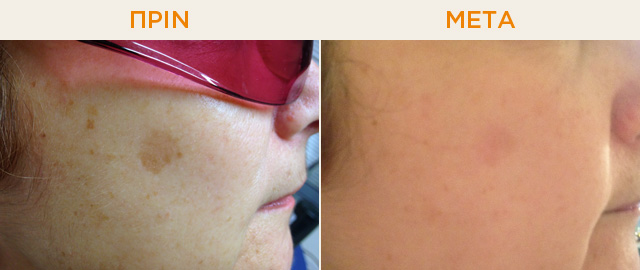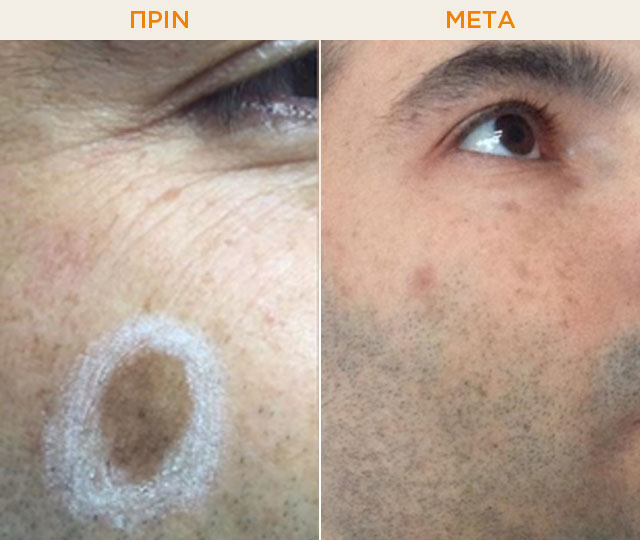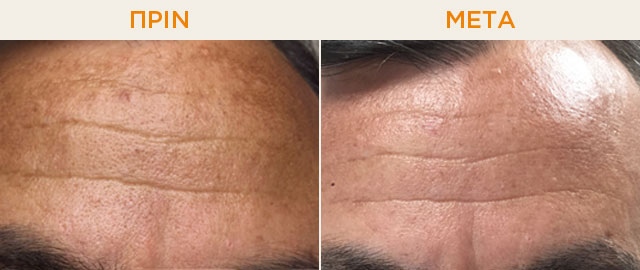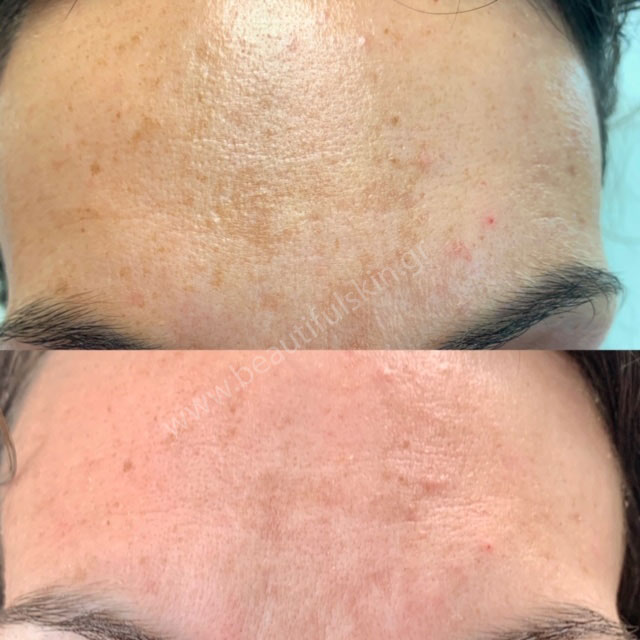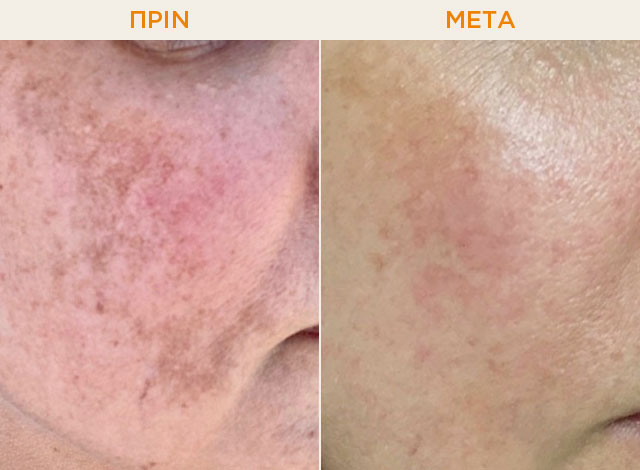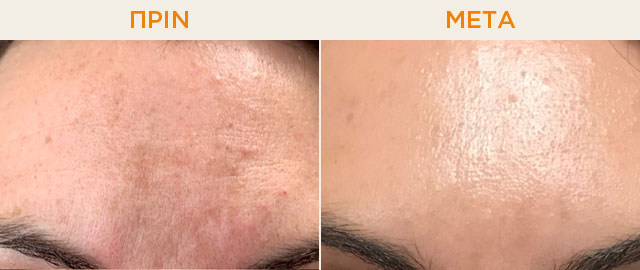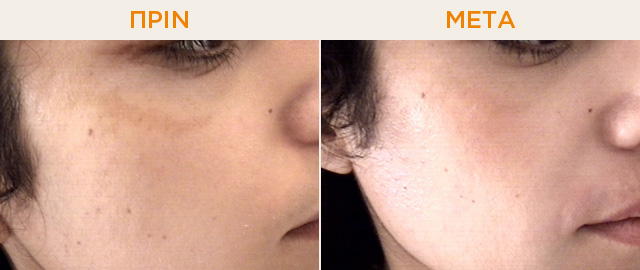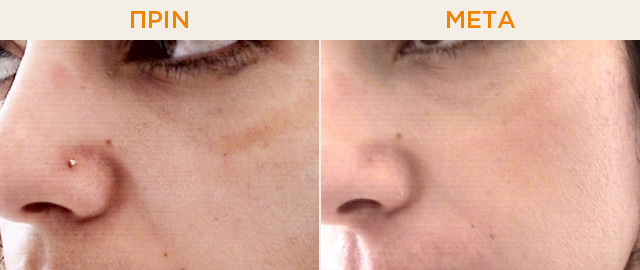Pigmented Spots - Brown Spots
The cumulative effect of ultraviolet radiation, i.e. the exposure to the sun from our childhood, has adverse effect (undesirable effects) on even skin tone. Thus, while at the of 20, the sun ‘flatters’ the facial features with the tan, while after the age of 30, it begins to leave its marks on those people who had not taken care to protect themselves in time.
However, not all skin types have the same behavior. The light-skinned people are more likely to develop brown spots (solar lentigines) that are outlined, usually small lesions that "fade" during winter, but then are visible throughout the year. Also, the post-inflammatory hyperpigmentation spots appear in the form of discolorations, i.e. brown spots on areas where there was a pre-existing skin irritation, e.g. from acne pimples, especially on dark-skinned individuals. Darker skin types are more resistant and show sun spots later; however some skin types may appear melasma. Melasma or chloasma (or ‘mask of pregnancy’) is a more diffuse pigmentation disorder that has an inherited predisposition but it is also caused by the chronic sun exposure. It may appear on the forehead (as a "patch"), on the cheekbones or the upper lip (as a "mustache"); if it is left untreated, it is extended over the years and is appeared diffuse in many areas of the face. It is a difficult aesthetic problem and psychologically affects patients who have a strong need for constant coverage with makeup. It should be noted that melasma can occur at a much lower frequency in men, while in women the predisposing factors can also be due to hormonal reasons (pregnancy, intake of contraceptive pills or other hormones for reproduction).
In contrast to spots that can appear anywhere on a sun-exposed skin, e.g. on the dorsal side of the hands, the decollete, etc., melasma appears exclusively on the face. The age of melasma onset is between mid-20s and late 30s. The darker-skinned individuals are more prone to melasma, while it is common among Asians in addition to the Mediterranean populations.
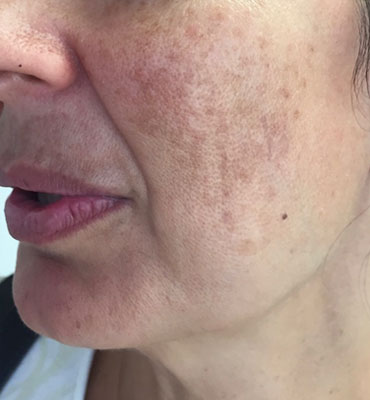
Μέλασμα διάχυτο στην αριστερή παρειά.
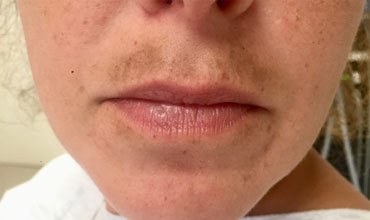
Μέλασμα με εντόπιση άνω χείλος.
How to Treat Brown Spots?
The treatment of brown spots and melasma is performed in the dermatological clinic during winter, while the prevention of new lesions or recurrence of melasma requires strict sun protection all year round.
Depending on the skin type and the color of the spots, we choose a different treatment. The outlined relatively dark spots on light skin color are ideally treated with Alexandrite Laser in special settings having excellent result of complete elimination. Initially, a scab is formed (the surface darkens and makes a small crust) which we take care of with regenerating creams and sunscreen.
It may take 10-15 days depending on the location (e.g. in the hands it takes longer for the crust to fall off), for the healing and disappearance of the spots. Only one session is required; while if we have many different colored brown spots, we combine with other treatments, e.g. peeling. In lighter-colored spots, usually larger in diameter, we apply different treatment protocols. Either we apply cryotherapy treatment (this treatment involves freezing the skin with a small amount of liquid nitrogen) or exfoliating treatments with special whitening peelings; if we are also interested in the overall quality of the skin, we apply oxygen therapy with whitening agents. Another, very effective treatment for brown spots is mesotherapy for more luminous and rejuvenating skin. Mesotherapy is performed using thin needles where special peptides with a whitening effect are injected that brighten the whole face and act on the deeper layers of the skin. Thus, along with the disappearance of the brown spots, we achieve a more radiant and bright skin. These treatments leave no redness or irritation or scaling and can be repeated every 15 days for a complete result (3 treatments in total).
On darker colored skin with melasma, the treatment is more difficult. It may precede skin preparation for 2 weeks with a special cream and then apply the peeling that renews the skin and also has anti-aging action. If the intense flaking is not desired, the peeling is performed with less intensity, so that the exfoliation is less. In this case, we repeat the process after a month. We can apply it up to 3-4 a year with excellent results in anti-aging, too.
In case that the exfoliation (peeling) is not possible for several reasons such as the patient does not want it or the conditions of her daily life do not allow it, we have the option of microdermabrasion with crystals; This treatment give immediate brighter and smoother skin without causing any irritations, preparing it for a 6 weeks special whitening treatment at home with the use of a cream with a strong whitening effect. It contains hydroquinone, a powerful skin-lightening agent. This treatment is suitable for melasma, but also for brown spots that do not whiten with any of the above-mentioned ways.
It must be noted that some cases of melasma are very persistent and there we achieve great improvement but we do not eliminate the problem. This occurs in not recent but old diffuse discolorations where the pigmentation is located in the lower layers of the skin. In such cases, the Wood lamp, a lamp with special lighting, can help us diagnose which spots are too deep in the skin for responding and thus making the correct prediction for the effectiveness of our treatment.
Another treatment option is Fractional CO2 Laser that, in addition to discoloration, it also treats rough skin, fine wrinkles (or fine lines) and open pores. In this treatment, the intensity is also adjustable, so that if we are mainly interested in discolorations we have a short recovery time. The treatment can be repeated every month in winter.
General (but necessary) instructions
Whatever the discoloration treatment, a maintenance treatment for the optimum results with a home treatment and sun protection is necessary. The maintenance treatment includes non-irritating creams with bleaching agents such as Kochic acid, Vitamin C, Azelaic acid and Peptides and can be applied during the summer period.
Also, it is very important to choose the right sunscreen with protection for UVA and UVB radiation that must be applied every 3 hours. The UVA radiation that is responsible for photoaging and melasma, passes through the windows. So, we can get dark spots even when we are behind the window without SPF. The sunscreen should also be worn indoors as well as in bright places and in the car. In prolonged exposure, the use of a hat with a visor is imperative. For the case of women who need to wear make-up, there are sunscreens in the form of powder for renewal of the sunscreen or sunscreens with the form of spray that are applied over the make-up. For spots on the hands, a good protection solution is driving gloves.
In cases of spots, the prevention is enough after their treatment; while melasma often recurs in many cases due to the extended season with sunshine, even with the continuous use of sunscreen. This is why patients with melasma usually repeat the whitening treatments every winter, in order to prevent melasma from spreading over time.
It should also be noted that the treatment with tranexamic acid pills has been shown to be useful in treating melasma in addition to other therapies. The treatment is given by the dermatologist and it lasts 6 months. It has no side-effects.
Is treatment allowed in pregnant or breastfeeding women?
During pregnancy, only sun protection and microdermabrasion are allowed. The use of creams with hydroquinone and other drugs is prohibited during breastfeeding. Lasers, microdermabrasion, peptides, oxygen therapy and some peelings are allowed.
Is there any risk in relation to brown spots?
Plain brown spots (solar lentigines) do not pose a health risk. However, there are lesions that look like brown spots, such as some types of melanoma (lentigo maligna) that only a dermatologist can differentiate as they develop very slowly and therefore the patient is not worried.
Treatment with the use of Laser
Facial skin whitening, especially if the brown spots are diffuse, is treated with the use of laser in combination with special whitening creams containing hydroquinone. We treat the whole face area and after a week we notice a fine exfoliation (scaling). In this way, the ingredients of the whitening creams penetrate much more effectively, while the discolorations on the skin surface disappear. It is necessary to use sunscreen as morning care.
Also, another suggested treatment for facial whitening is mesotherapy with injection of special whitening substances and peptides on the discolorations. This treatment is recommended for those who do not want any treatments that cause flaking; while they are completely targeted at the areas with discolorations. 3 sessions are required, 1 every 15 days.



